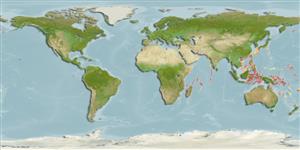>
Holocentriformes (Squirrelfishes, soldierfishes) >
Holocentridae (Squirrelfishes, soldierfishes) > Myripristinae
Etymology: Ostichthys: Greek,osteon = bone + Greek, ichthys = fish (Ref. 45335).
More on authors: Randall, Shimizu & Yamakawa.
Environment: milieu / climate zone / depth range / distribution range
Ecologie
marien rifbewoner; diepte 270 - 355 m (Ref. 114923). Subtropical
Western Pacific: Japan (Ryukyu Is,), New Caledonia (Chesterfield Is.) and Vietnam.
Grootte / Gewicht / Leeftijd
Maturity: Lm ? range ? - ? cm
Max length : 17.0 cm SL mannelijk / geslacht onbekend; (Ref. 28618)
Korte beschrijving
Determinatiesleutels | Morfologie | Morfometrie
Dorsale stekels (totaal) : 12; Dorsale zachte stralen (totaal) : 13 - 14; Anale stekels: 4; Anale zachte stralen: 10 - 11. This species is distinguished by the following characters: D XII, 13-14 (modally 13); pectoral-fin rays 15-16 (15); pored lateral-line scales 27-28 (28); scale rows between lateral line and middle of spinous dorsal-fin base 3.5; lower gill rakers including all rudiments 11-13 (13); the middle dorsal-fin spines are relatively long, 7th dorsal-fin spine 15.5-17.7 (mean 16.8) of SL; 10th and 11th (penultimate) dorsal-fin spines relatively long (tenth dorsal-fin spine 8.4-11.0 (9.9) % of SL while the eleventh is 6.3-9.4 (7.8) % of SL); posteriormost (12th) dorsal-fin spine is relatively short, its length 5.0-7.6 (6.5) % of SL; second to fourth anal-fin spines relatively long: the second is 6.4-8.3 (7.1) % of SL, the third is 16.5-19.2 (17.9) % of SL, the fourth is 12.1-15.1 (13.5) % of SL; caudal peduncle is relatively short, its length 9.3-10.4 (9.9) % of SL; the separation between last dorsal-fin spine and first dorsal-fin soft ray bases are similar to that between former and penultimate dorsal-fin spine base; the first body scale row is usually below first dorsal-fin spine base (80%), sometimes reaching between bases of first and second dorsal-fin spines (20%); in large specimens, the ventral portion of maxilla is expanded ventrally; body scales with many well-developed, closely set spinules, fewer less developed (young) spinules. When fresh, narrow longitudinal white bands or rows of white spots present laterally on body (including large specimens), but may be lost following preservation (especially long term); a white blotch on the uppermost part of pectoral-fin base (Ref. 119380).
Levenscyclus en paargedrag
Maturities | Voortplanting | Spawnings | Egg(s) | Fecundities | Larven
Greenfield, D.W., J.E. Randall and P.N. Psomadakis, 2017. A review of the soldierfish genus Ostichthys (Beryciformes: Holocentridae), with descriptions of two new species in Myanmar. J. Ocean Sci. Found. 26:1-33. (Ref. 114923)
Status op de Rode Lijst van het IUCN (Ref. 130435)
Gevaar voor de mens
Harmless
Gebruik door de mens
Tools
Speciale rapporten
Download XML
Internetbronnen
Estimates based on models
Preferred temperature (Ref.
123201): 14.7 - 24.3, mean 20 °C (based on 140 cells).
Fylogenetische diversiteitsindex (Ref.
82804): PD
50 = 0.5001 [Uniqueness, from 0.5 = low to 2.0 = high].
Bayesian length-weight: a=0.01778 (0.00680 - 0.04650), b=3.02 (2.79 - 3.25), in cm total length, based on LWR estimates for this (Sub)family-body shape (Ref.
93245).
Trofisch niveau (Ref.
69278): 3.8 ±0.6 se; based on size and trophs of closest relatives
Weerstandsvermogen (Ref.
120179): Hoog, minimale populatieverdubbelingstijd minder dan 15 maanden (Preliminary K or Fecundity.).
Fishing Vulnerability (Ref.
59153): Low vulnerability (11 of 100).
